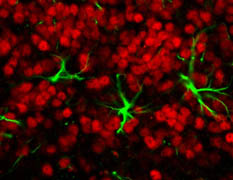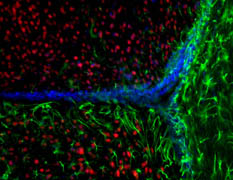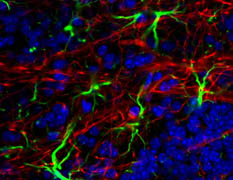|
This web page is part of the Michigan Today Archive. To see this story in its original context, click here.

Images 1 and 2 (OB): A view inside the olfactory bulb of an adult mouse (the region of the brain that processes odor perception) in which neurons are red and neural helper cells called astrocytes are in green. While the creation of new neurons in the olfactory bulb generally declines with age, the Nature paper shows that deletion of the gene P16Ink4a partially rescues this age-related decline in neurogenesis.
|

A view inside the olfactory bulb of an adult mouse (the region of the brain that processes odor perception) in which neurons are in green and cell nuclei are in blue. While the creation of new neurons in the olfactory bulb generally declines with age, the Nature paper shows that deletion of the gene P16Ink4a partially rescues this age-related decline in neurogenesis.
|
 |

This is a view of the forebrain of an adult mouse. Neurons are in red, neural helper cells called astrocytes are in green, and nuclei are in blue. Neural progenitor cells in this part of the forebrain give rise to new neurons throughout life but this neurogenesis declines with age. The Nature paper shows that deletion of the gene P16Ink4a partially rescues this age-related decline in neurogenesis. |
|
|
|
|
|
Michigan Today News-e is a monthly electronic publication for alumni and friends.
|
Michigan Today
online alumni magazine
University Record
faculty & staff newspaper
MGoBlue
athletics
News Service
U-M news
Photo Services
U-M photography
University of Michigan
gateway
Unsubscribe
Previous Issues
|





